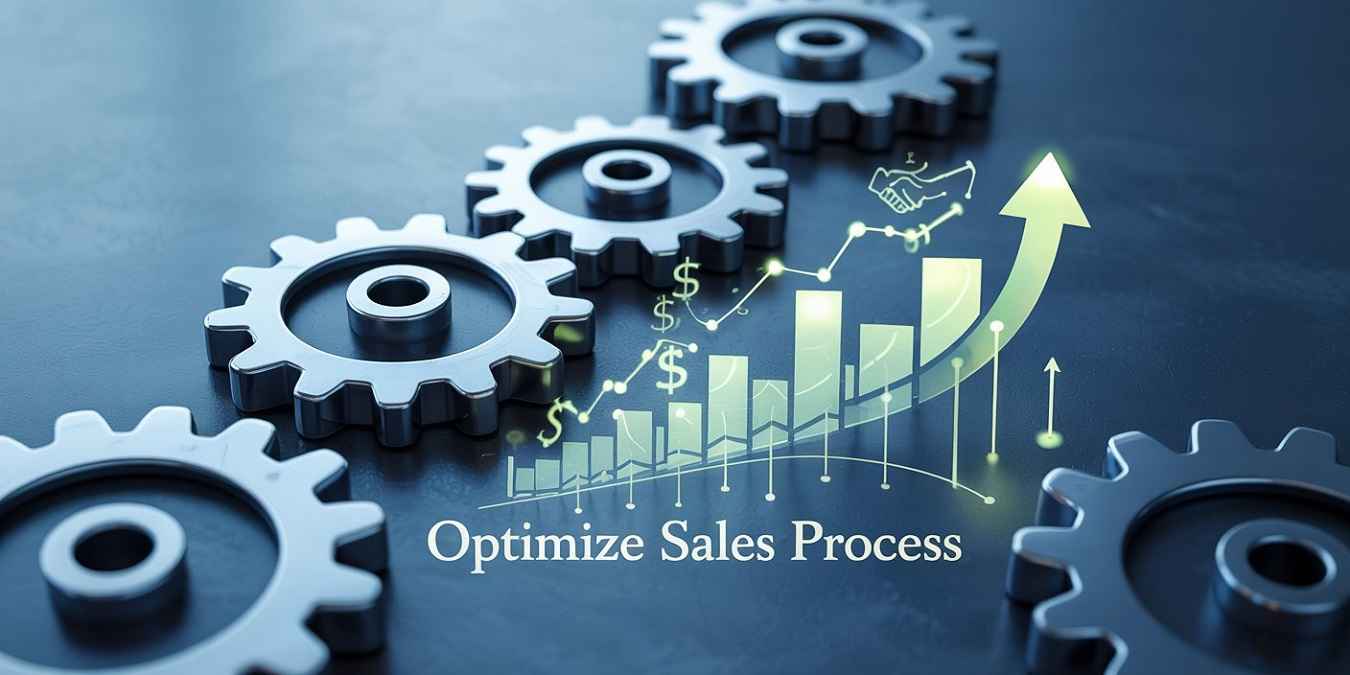
How to Optimize Sales Process for Maximum Growth
Are you looking to optimize sales process for maximum growth? If so, you’ve landed in the right spot. Every business wants to boost revenue, delight customers and outpace competitors. Optimizing your sales process is the key to making that happen. It’s about fine-tuning every step, from finding leads to sealing the deal, so you can work smarter, not harder. The result? Maximum growth and a thriving business.
In this guide, we’ll walk you through how to optimize sales process step by step. You’ll learn how to assess what you’re doing now, apply proven strategies, put changes into action and measure your success. We’ll keep it simple, practical and straight to the point. Ready to transform your sales game? Let’s get started.
Understanding Your Current Sales Process
Before you can optimize sales process, you need to know what’s happening right now. Take a hard look at your sales funnel. Where are the hiccups? Think of it like a road trip: if there’s a traffic jam, you won’t reach your destination on time.
Why Assess Your Process?
Why does this matter? Because you can’t fix what you don’t understand. Assessing your current setup shows you what’s working and what’s not. It’s your baseline for growth. Without it, you’re guessing and that’s no way to run a business.
Spotting the Weak Spots
Here are some common roadblocks you might find.
- Leads That Go Nowhere: Are you chasing the wrong people? Unqualified leads waste your time.
- Slow Follow-Ups: How fast do you reply to inquiries? Waiting too long can lose you deals.
- One-Size-Fits-All Pitches: Are your sales talks tailored or generic? Customers want to feel special.
- Untrained Team: Do your reps have the skills they need? Weak training equals weak results.
- Neglected Relationships: Are you ignoring past customers? Repeat business is gold.
So, what’s your biggest headache? Pinpointing it helps you focus your efforts where they’ll count most.
The Ripple Effect
These issues don’t just annoy you, they hit your wallet. A leaky sales funnel means lost opportunities. Slow responses turn hot leads cold. But a smooth customer journey? That’s where the magic happens. Higher conversions, happier clients, more revenue.
Optimizing your sales process isn’t just about patching holes. It’s about making good things great. As Abraham Lincoln once said, “The best way to predict the future is to create it.” Assessing your process is the first step to building that future.
Strategies to Optimize Sales Process
Got a handle on your current setup? Great. Now let’s talk about how to make it better. Optimizing your sales process means sharpening four big areas, lead generation, sales techniques, customer relationships and data. Each one can supercharge your results.
-
Lead Generation and Qualification
Your sales process starts with leads. But quality beats quantity every time. Here’s how to get it right.
- Target Smart: Stop chasing everyone. Use marketing that hits your ideal customer, think blog posts, ads or emails aimed at their needs.
- Score Your Leads: Not every lead is worth your time. Rank them based on who’s most likely to buy. Focus there.
- Nurture Patiently: Some leads need time. Keep them warm with helpful tips or personal messages until they’re ready.
What’s one way you could attract better leads? Small tweaks here can save you hours later.
-
Sales Techniques and Training
Your team makes or breaks your sales process. Equip them to shine.
- Train Regularly: Skills fade without practice. Workshops or online courses keep your team sharp.
- Give Them Tools: CRM software or ready-made scripts can speed things up. Efficiency matters.
- Push Personalization: Ditch the cookie-cutter pitch. Show customers you get them, address their specific problems.
When did you last boost your team’s skills? A little training goes a long way.
-
Customer Relationship Management
Happy customers stick around. A solid CRM strategy keeps them coming back.
- Get a CRM Tool: Track every call, email and sale in one place. It’s a game-changer for staying organized.
- Focus on Retention: New customers are great, but old ones are cheaper to sell to. Look for upsell chances.
- Make It Personal: Use CRM data to customize your approach. A simple “Hey, Sarah” beats a bland “Dear Customer.”
How well do you know your clients? Digging into their needs builds loyalty.
-
Data Analytics and Performance Metrics
Numbers don’t lie. Use them to guide your sales process.
- Watch the Big Metrics: Track conversion rates, deal sizes and how long sales take. These show you what’s up.
- Spot Patterns: Data reveals trends, like which products sell fast or where leads drop off.
- Tweak as Needed: If something’s off, change it. Flexibility keeps you ahead.
Are you letting data steer your decisions? It’s the smartest way to grow.
Implementing Changes
You’ve got strategies. Now it’s time to act. Change can feel tricky, but it doesn’t have to be. Here’s how to roll it out smoothly.
Take It Slow
Don’t flip everything upside down at once. Start with one piece, like better lead scoring. Master that, then move on.
Talk It Out
Tell your team why this matters. Show them how it’ll make their lives easier and the business stronger. Buy-in beats pushback.
Back Them Up
Change can rattle people. Offer training or check-ins to keep them confident. Support smooths the bumps.
Stay Patient
Results won’t come overnight. Progress might be slow at first. Celebrate the small wins, they add up.
What’s one change you could try today? Even a tiny step starts the momentum.
Measuring Success
How do you know your hard work paid off? By tracking the right numbers. Key performance indicators (KPIs) tell the story of your sales process.
Key Metrics to Watch
- Conversion Rate: How many leads become customers? This shows your process’s punch.
- Sales Cycle Time: How long from first contact to sale? Shorter is usually better.
- Acquisition Cost: What’s it cost to win a customer? Lower costs mean higher profits.
- Lifetime Value: How much does a customer spend over time? This ties to growth.
Act on What You See
Check these numbers often. If conversions climb, you’re on track. If not, dig into why. Adjust your approach based on facts, not feelings.
What KPIs are you tracking now? Pick a couple and watch them closely, they’ll guide your next moves.
Conclusion
Optimizing your sales process is a journey, not a quick fix. It starts with knowing where you stand. Then, you layer in smart strategies, better leads, sharper skills, stronger relationships and solid data. Implementing those changes takes effort, but the payoff is worth it. Measure your wins, tweak what’s off and keep pushing forward.
Why bother? Because a streamlined sales process drives maximum growth. It’s your ticket to more sales, happier customers and a business that thrives. Like Abraham Lincoln said, “The best way to predict the future is to create it.” You’re in the driver’s seat here.
Ready to optimize sales process for maximum growth? Start today. Pick one area to improve, maybe lead quality or team training. Take that first step, track your progress and watch your business climb. Your next big win is waiting, go grab it!
FAQs for “How to Optimize Sales Process for Maximum Growth”
Q: What is the first step in optimizing my sales process?
A: The first step is to assess your current sales process to identify areas for improvement. This involves understanding your sales funnel, spotting weak points like unqualified leads or slow follow-ups and recognizing where your process can be streamlined for better results.
Q: How can I improve my lead generation?
A: You can improve lead generation by targeting your marketing efforts more effectively to attract your ideal customers, scoring leads to focus on those most likely to convert and nurturing them with personalized messages to build interest over time.
Q: What are some effective sales techniques I can use?
A: Effective sales techniques include personalizing your pitches to address each customer’s specific needs, using CRM tools to track interactions and stay organized and focusing on building long-term relationships with customers to encourage repeat business.
Q: How do I implement changes to my sales process without disrupting my team?
A: Implement changes gradually by starting with one area, such as lead scoring or follow-up times. Communicate the reasons for the changes to your team, provide training and support to help them adapt and celebrate small wins to maintain morale.
Q: How can I use data analytics to improve my sales process?
A: Use data analytics to track key performance indicators (KPIs) like conversion rates and sales cycle times, identify trends in customer behavior and make data-driven decisions to continuously optimize sales process.
Q: What metrics should I track to measure the success of my sales process optimization?
A: Track metrics such as conversion rate, sales cycle time, customer acquisition cost and customer lifetime value. These KPIs will help you measure the effectiveness of your optimizations and guide further improvements.
Further Reading (Books)
- “Sales Growth: Five Proven Strategies from the World’s Sales Leaders“
This book offers actionable strategies from top sales leaders to accelerate revenue and refine sales processes.“ - The Sales Development Playbook: Build Repeatable Pipeline and Accelerate Growth with Inside Sales“
Focuses on building scalable sales pipelines and aligning strategies to drive consistent growth. - “Process Optimization Sales Third Edition”
A comprehensive guide to streamlining sales processes for efficiency and growth, with practical frameworks. - “Insight Selling”
Introduces a value-driven approach to sales by leveraging customer insights to close deals effectively. - “The Challenger Sale: Taking Control of the Customer Conversation“
A foundational text on modern sales strategies, emphasizing proactive engagement to drive growth.














